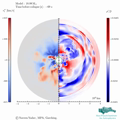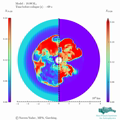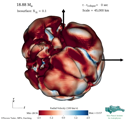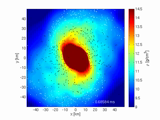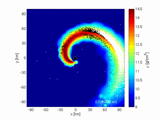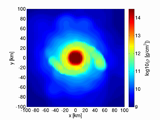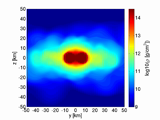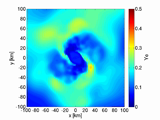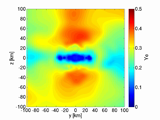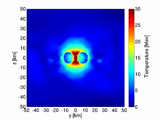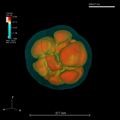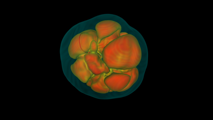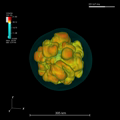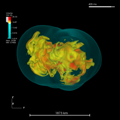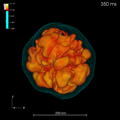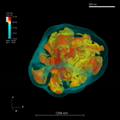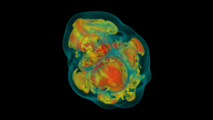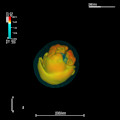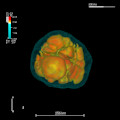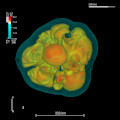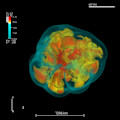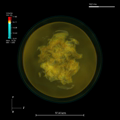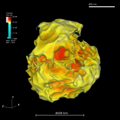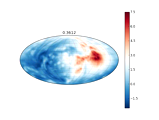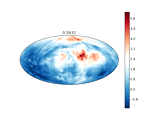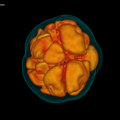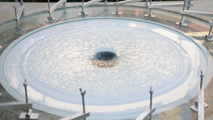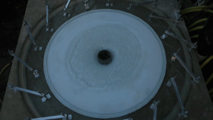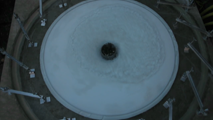Movie archive
The following movies show visuals of three-dimensional core-collapse supernova simulations, pre-collapse simulations of supernova progenitors, and neutron-star merger simulations done by the Garching group.
If you want to use these files for any purposes, please contact Hans-Thomas Janka (thj mpa-garching.mpg.de).
mpa-garching.mpg.de).
Formation and Evolution of the Supernova Remnant Cassiopeia A
Originating from a Neutrino-driven Explosion
Wongwathanarat, Janka, Müller, et al., 2017, ApJ, 842, 13
Orlando, Wongwathanarat, Janka, et al., 2021, A&A, 645, A66
Orlando, Wongwathanarat, Janka, et al., 2022, arXiv:2202.01643
Stars exploding as supernovae are the main sources of heavy chemical
elements in the Universe. In particular, also radioactive atomic nuclei are synthesized
in the hot, innermost regions during the explosion and can thus serve as probes of the
unobservable physical processes that initiate the blast. Elaborate computer simulations,
performed by a team of researchers from the Max Planck Institute for Astrophysics (MPA),
INAF - Osservatorio Astronomico di Palermo, and RIKEN in Tokyo, demonstrate the evolution
of the roughly 350 years old Cassiopeia A supernova remnant with its asymmetric
distribution of chemical elements from the onset of the neutrino-driven explosion to its
present state and more than 1500 years into the future.
For the first day of the explosion, see
this link
and interactive 3D visualizations of the spatial distributions of radioactive
56Ni
and
44Ti
ejected in the neutrino-driven supernova simulation of
Wongwathanarat et al. (2017).
For the long-time evolution from the first day to the supernova remnant,
see the following movies:
Movie 1
(downloads:
mov,
mp4,
mp4_LR):
Development of the expanding, asymmetric distribution of iron until 2000 years
Movie 2
(downloads:
mov,
mp4,
mp4_LR):
Distribution of iron and silicon nowadays (year 359)
Movie 3
(downloads:
mov,
mp4,
mp4_LR):
Distribution of iron and radioactive 44Ti nowadays
(see context of Fig. 12 of
Orlando et al. (2021))
Movie 4
(downloads:
mov,
mp4,
mp4_LR):
Mass fraction and abundance ratios of iron and 44Ti nowadays
(see context of Fig. 15 of
Orlando et al. (2021))
Movie 5
(downloads:
mp4,
mp4_LR):
Distribution of iron and titanium nowadays (year 359)
Large-Scale Mixing in a Violent Oxygen-Neon Shell Merger Prior to a Core-Collapse Supernova
Yadav
1, Müller
2,3, Janka
1, Melson
1, & Heger
4,5,6,
ApJ 890, 94 (2020),
NASA/ADS,
arXiv eprint
1905.04378
(1) Max Planck Institute for Astrophysics,
(2) Queen's University Belfast,
(3) Monash University,
(4) University of Minnesota,
(5) Shanghai Jiao-Tong University,
(6) Michigan State University.
Movie 1: Slice showing time evolution of the density (right) and radial velocity (left) fluctuations in the 18.88 solar mass presupernova model. Note: The time runs from -420 to zero seconds, as the collapse time is used as the reference time.
Movie 2: Slice showing time evolution of the Ne (right) and Si (left) mass fractions in the 18.88 solar mass presupernova model. The animation exhibits the `shell merger' described in the paper. Note: The time runs from -420 to zero seconds, as the collapse time is used as the reference time.
Movie 3: 3D surfaces at constant Si mass fraction (0.1) showing the mixing of Si in the 18.88 solar mass presupernova model. The surfaces are color coded according to the radial velocity. The animation clearly shows the large scale asymmetries in the Si distribution. Note: The time runs from -420 to zero seconds, as the collapse time is used as the reference time.
Compact object mergers
O. Just, A. Bauswein, R. Ardevol Pulpillo, S. Goriely, & H.-Th. Janka,
MNRAS 448, 541 (2015),
NASA/ADS,
arXiv eprint
1406.2687
R. Ardevol-Pulpillo, H.-T. Janka, O. Just, & A. Bauswein,
MNRAS 485, 4754 (2019),
NASA/ADS,
arXiv eprint
1808.00006
Movie 1: Merger of two NSs of 1.35 M_sun described by the DD2 EoS.
This simulation was performed with the SPH-CFC code described in Oechslin et al. (2007)
and Bauswein et al. (2010). One can see color coded the matter density. The black dots
represent some of the SPH particles (projected onto the equatorial plane) that will get
unbound from the system during the collision, turning white at the moment they fulfill
the ejecta criterion. The time in the lower right corner is normalized to the time when
the lapse function reaches its first minimum. This simulation includes the effects of
neutrinos using the ILEAS scheme (see Ardevol-Pulpillo et al. 2019). However, they have
no dynamical impact on the evolution of the merger.
Movie 2: Merger of a NS of 1.35 M_sun described by the DD2
EoS with a BH of 5 M_sun with spin 0.5. This simulation was performed
with the SPH-CFC code described in Oechslin et al. (2007) and Bauswein
et al. (2010), with the modifications to include BHs described in Just
et al. (2015). One can see color coded the matter density and the
position of the BH is indicated by a filled black circle, whose radius
in isotropic coordinates is defined by the gravitational mass of an
isolated, non-rotating BH. The black dots represent some of the SPH
particles (projected onto the equatorial plane) that will get unbound
from the system during the collision, turning white at the moment they
fulfill the ejecta criterion. The time in the lower right corner is
normalized to the time when half of the initial NS mass is accreted onto
the BH.
Movies 3 - 7: Symmetric merger of two NSs of 1.35 M_sun described by
the DD2 EoS. This simulation was performed with the SPH-CFC code described in Oechslin et
al. (2007) and Bauswein et al. (2010) and includes the effects of neutrinos using the ILEAS
scheme (see Ardevol-Pulpillo et al. 2019). Movies 3/4: horizontal/vertical slices
showing the time evolution of the matter density; movies 5/6: horizontal/vertical
slices showing the Y_e evolution; movie 7: vertical slice showing the temperature
evolution.
Rotation-supported neutrino-driven supernova explosions in three dimensions and the critical luminosity condition
The three movies visualize the core collapse of a 15 solar-mass progenitor without rotation, with rotation as computed by stellar evolution, and with artificially enhanced rotation as described in the paper. Only the last model explodes within the simulated evolution up to ~500 ms after core bounce.
Neutrino-driven explosion of a 20 solar-mass star in three dimensions enabled by strange-quark contributions to neutrino-nucleon scattering
The following two movies visualize three-dimensional core-collapse supernova simulations of a 20 solar-mass star. In the non-exploding model 3Dn, the default neutrino opacity set was used, whereas in the successfully exploding simulation 3Ds, strange-quark contributions to the nucleon spin were taken into account. Surfaces of high entropy are shown with appropriate color coding. The shock surfaces are visible by semi-transparent blueish layers above the buoyant bubbles. (Visualizations by Elena Erastova, Markus Rampp, and Aaron Döring, MPCDF and MPA)
Frames of 3Ds movie:
Neutrino-driven supernova of a low-mass iron-core progenitor boosted by three-dimensional turbulent convection
These movie show the neutrino-driven explosion of a 9.6 solar-mass progenitor star. The color-coding refers to the entropy per baryon, which is a measure for the heating of the stellar gas by neutrinos. The time after core bounce is displayed in the top right corner starting at 10 milliseconds. One rendering follows the evolution of the shock, the other focuses on the ejecta. (Visualization by Elena Erastova and Markus Rampp, MPCDF)
Self-sustained asymmetry of lepton-number emission: A new phenomenon during the supernova shock-accretion phase in three dimensions
Evolution of the neutrino emission asymmetry in a collapsing star of 9.6 solar masses. The ellipses represent the whole surface of the nascent neutron star (analog to world maps as planar projections of the Earth's surface). Red means a large excess of electron neutrinos compared to electron antineutrinos normalized to the average, blue means a low excess or even deficit of electron neutrinos. The time is running in seconds after core bounce.
SASI activity in three-dimensional neutrino-hydrodynamics simulations of supernova cores
First movie: The mushroom-like bubbles are characteristic of "boiling" neutrino-heated gas, whereas the standing accretion-shock instability (SASI) causes wild sloshing and rotational motions of the whole neutrino-heated layer (red) and of the enveloping supernova shock (blue). (Visualization by Elena Erastova and Markus Rampp, MPCDF)
Other movies: The "SWASI" experiment demonstrates the dynamical processes in the supernova interior by a circular water current that is fed by a ring-shaped reservoir and flows radially over a curved surface towards a central pipe, where it exits the experimental setup. The deceleration before entering the pipe leads to a backwater step in the water flow, a so-called hydraulic jump. The water corresponds to the collapsing gas in the supernova core, the pipe mimics the matter accreting neutron star, and the hydraulic jump plays the role of the stagnant supernova shock in the stellar core. For ideal conditions the hydraulic jump stays nearly circular. When the water flow is increased, the symmetry is broken because an instability leads to the oscillatory growth of violent sloshing motions or spiralling motions of the whole region enclosed by the hydraulic jump. This "SWASI" phenomenon is an analogue of the SASI instability occurring in the supernova core, but it is one million times smaller and about one hundred times slower than its astrophysical counterpart. (Videos by Thierry Foglizzo, Laboratoire AIM Paris-Saclay, CEA)
Three-dimensional simulations of mixing instabilities in supernova explosions
First movie: Three-dimensional simulation of the first 0.5 seconds of the explosion of a 15.5 solar-mass blue supergiant star. The entropy per baryon being a measure for the heating of the stellar gas by neutrinos is color-coded. The bluish, nearly transparent surface marks the position of the shock front. (Visualization by Leonhard Scheck, MPA)
Second movie: Three-dimensional simulation of the explosion of a 15.5 solar-mass blue supergiant star up to 9000 seconds after core bounce showing the outward mixing of certain elements. The blue structures contain a dominant mass fraction of nickel, the red fingers mostly oxygen, and green is associated with carbon. A mixture of nickel and oxygen appears in pink. At the end of the simulation, the shock has already broken out of the stellar surface. (Visualization by Markus Rampp, MPCDF)

 mpa-garching.mpg.de).
mpa-garching.mpg.de).